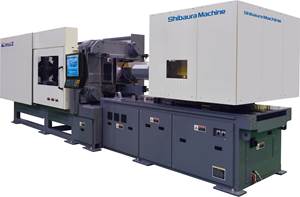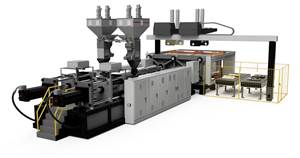Gas Assist Works for Thermosets and Smaller Parts, Too
The first gas-assist injection molding process for thermosets, and the use of gas assist for molding smaller parts were two new areas explored in papers presented at the 13th International Molding Conference and Exhibit held in February in New Orleans.
The first gas-assist injection molding process for thermosets, and the use of gas assist for molding smaller parts were two new areas explored in papers presented at the 13th International Molding Conference and Exhibit held in February in New Orleans.
Thermosets gas up
Long cycle times have hampered the ability of thermoset materials to fend off the penetration of glass-filled thermoplastics into thick-section parts for high-temperature applications. The push of thermoplastics into these markets where thermosets are replacing metal is occurring even though thermosets are lower in price and deliver higher rigidity and heat resistance, says Len Nunnery, corporate quality director for Bulk Molding Compounds Inc. (BMCI), a supplier of thermoset BMC compounds. Nunnery sees increasing pressure on thermosets by thermoplastics in high-heat applications (above 200 F) partly because of the cost and cycle-time savings made possible by gas-assist molding.
To meet this challenge, BMCI developed a gas-assist injection process for use with thermoset materials. It can lower cycle times and material usage by one-third to one-half, Nunnery says, adding that the process can be adapted to existing machinery. The firm has just received a patent but says it will not require licenses from molders if they purchase their material from BMCI.
In its development work, BMCI used gas-assist equipment from Cinpres Gas Injection (CGI). BMCI uses a “push-back” rather than a short-shot gas-assist process. Initial trials showed that thermoset BMC is too viscous to be “inflated” by gas in the manner of thermoplastics. (The gas merely escapes through the vents.) Instead, BMCI learned to inject gas directly into the part through a hollow pin positioned as far as possible from the gate. The mold cavity is first completely filled with resin and packed out in the conventional manner. After a delay to allow a layer of thermoset to set up against the mold wall, the gas pin is activated. The gas then pushes soft, uncured material from the center of the part back into the injection barrel, where it will be used in the next shot.
The cored-out part contains less material, which reduces the cycle time dramatically. According to Nunnery, BMC does not show any surface imperfections such as bubbles or “fingering,” which can occur with thermoplastics. The timing of gas injection is critical, Nunnery notes. There is a direct correlation between the delay before the gas is injected and the thickness of the part wall. Although BMCI worked with gas pressures of 1000 psi, Nunnery believes gas pressures may be as low as 300 to 400 psi. Molders may even be able to use compressed air, Nunnery suggests.
The first commercial application is a 30-in. handle for a kitchen range. The process will push about 1.5 lb of material back into the barrel for reuse. That means material savings of about 40%. A solid part would typically take about 3 min to cure, while gas assist reportedly can achieve a cycle time of 45 sec. The cycle-time reduction permits use of a tool with fewer cavities on a smaller press.
Toilet seats may be the next application. “Normal solid toilet seats have a 7-min cycle time. All you need is a 0.100-in. wall, so gas assist can get it done in under 1 min,” Nunnery predicts.
BMC injection with gas assist could also be suited to automotive fascias, mirror housings, and spoilers, Nunnery says. Hollowed-out parts may provide sound-dampening properties that could be useful in valve covers or other under-the-hood jobs, he notes.
Gas solves small problems
Small thin-wall parts, or large flat panels with close tolerances are also new candidates for internal or external gas-assist methods, says Mark Paddock, v.p. and general manager at CGI. He says there is a general perception that gas-assist molding is mainly applicable to large or thick-section parts. Yet interest in applying gas assist to small parts is emerging in Taiwan and China. Small telecom and computer components like cell-phone housings and cradles or bases for personal digital assistants (PDAs) and other small electronic devices are emerging areas. Parts produced on 25-ton presses, with weights of a few grams and wall thickness down to 1.1 mm, are candidates for either internal or external gas assist, says Paddock. As in larger parts, gas assist can help solve shrinkage, warpage, and flatness problems.
The gas, when applied to a small part, primarily carries out a packing function, rather than hollowing out the part to a significant degree. “The elimination of molded-in stress is as important as the reduction of sink marks. And when stress is reduced, gas-assist can often eliminate the tendency for the part to distort after ejection from the mold.” Paddock adds.
Each application must be reviewed to determine whether an internal or external gas-molding method would be used. Internal gas molding typically cores or hollows out a part, a rib, or bosses, while external gas molding applies gas pressure to some or all of the non-appearance side of the part. Wall or rib thickness will help determine which is most suitable. Also, more intricate parts or tools are generally harder to mold with external gas, since sealing the tool can be difficult, especially if a high-shrink material is used, Paddock notes.
CGI says that standard gas nozzles (3 or 6 mm) can be used for small parts. However, lower volumes of gas are injected, so venting is less of a problem. Retractable nozzles are unnecessary, Paddock says, and fixed assemblies can be used.
Gas-assist was critical to the production of a computer mouse for Logi tech Inc. of Fremont, Calif. Three of the outer case parts are gas molded. The outer case used gas to achieve a sink-free surface adjacent to varying wall thicknesses. The smaller 3-gram center molding was gas molded to prevent sink marks opposite bosses. The finger buttons were molded by injecting gas downstream of each integral hinge, Paddock says.
Another example is a three-disk CD carrier. This ABS part had an average wall thickness of 1 mm but would bow 2 mm when molded using conventional injection methods. Thicker sections in the part tended to cause differential shrinkage and warpage. When CGI applied internal gas molding at three positions in the tool, the part showed a bow of just 0.2 mm, well within the part’s design specification.
CGI also reported that a cell phone produced conventionally showed sink marks next to its thicker hinge section. When external gas molding was applied, the sink marks vanished. In addition, reduced stresses in the part enabled the moldings to be painted without the risk of crazing—a condition that often results when high in-mold pressures cause high part-stress levels.
Finally, CGI cited the case of a notebook-computer case made of PC/ABS with a wall thickness of 1.5 mm. During trials, the only way to produce a flat part was to inject gas at eight positions to form gas channels around the periphery of the molding. The part is now in commercial production.
Related Content
Completely Connected Molding
NPE2024: Medical, inmold labeling, core-back molding and Industry 4.0 technologies on display at Shibaura’s booth.
Read MoreStructural Foam Injection Molding Line Extended
At K 2022, Wilmington Machinery introduced the dual-injection Lumina MP1200 medium pressure molding machine.
Read MoreFakuma 2023: Wittmann Battenfeld Expands All-Electric Line, Direct-Current Capabilities
Wittmann Battenfeld will introduce the new EcoPower B8X injection molding machine line and show direct current as an energy source for a concept machine that will power its own robot.
Read MoreInternal Gas Pressure Molding Offers Sustainability Benefits
Wittmann Battenfeld says its upgraded Airmould 4.0 technology, which features a more compact footprint, saves material and cycle time — thereby also cutting energy use.
Read MoreRead Next
New Methods Expand Roles of Gas-Assist Molding
Two variations on gas-assist injection molding were presented in papers at the Molding 2002 Conference held in New Orleans in March.
Read MoreInjection Molding Technologies Advance At Structural Plastics Show
A simpler approach to in-mold film decorating was one new injection molding capability presented at the SPI Structural Plastics show and conference.
Read MoreProcessor Turns to AI to Help Keep Machines Humming
At captive processor McConkey, a new generation of artificial intelligence models, highlighted by ChatGPT, is helping it wade through the shortage of skilled labor and keep its production lines churning out good parts.
Read More



















.png;maxWidth=300;quality=90)











